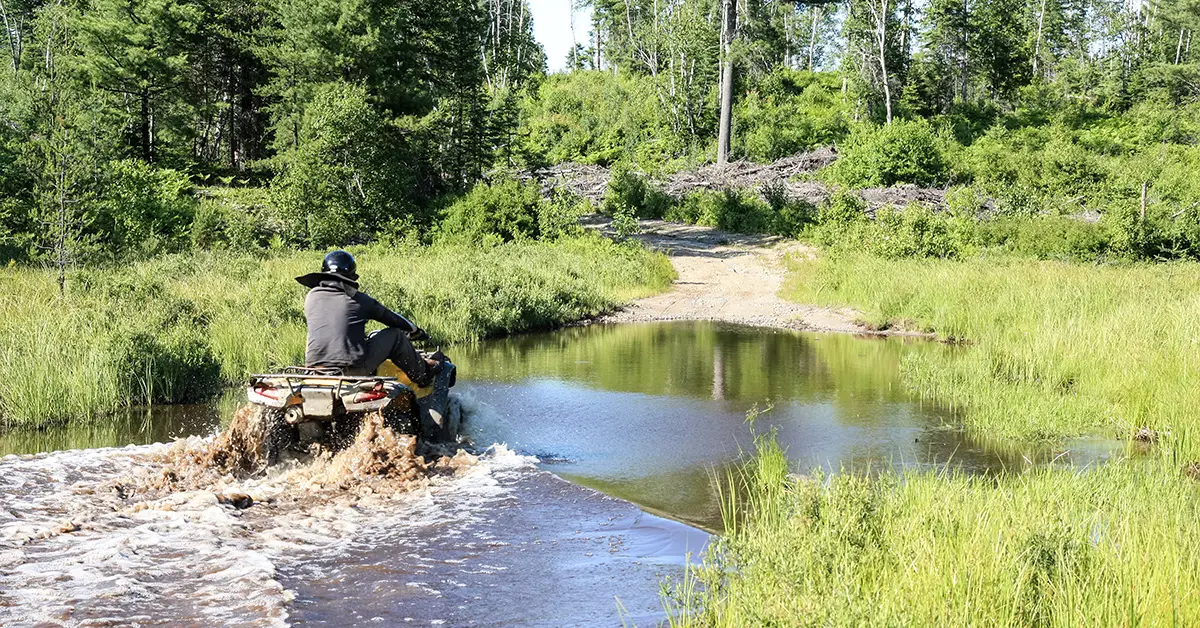Riding an ATV is a fun and thrilling way to explore the outdoors. The vehicle packs a lot of power to conquer some of the most unfriendly and extreme terrains.
However, off-road vehicles have limits. If you are planning to go for a ride through wet and muddy paths, you might be wondering whether it’s safe to submerge your vehicle in water.
You’re not alone. Many riders ask us if it’s OK to ride ATVs through deep mud holes and river streams. We thought it would be best to create a post addressing the concern.
So can ATVs go in water? Riding most quad bike models in water shouldn’t be a problem as long as the water doesn’t rise above the footboards. In other words, it’s safe to go through small creeks and streams. But even when in such areas, the exhaust pipe can sometimes go underwater. It’s advisable to keep your hand on the throttle to prevent water from finding its way into the exhaust system. Also, you’ll want to keep your speed below 4 miles per hour.
Stay with us to learn how deep can ATVs go in water, mistakes to avoid, and what to know when the water is snorkeling.
Table of Contents
How Deep Can ATV Go in water?
If you haven’t snorkeled your ATV, the safe depth to which your four-wheeler should be submerged is approximately 14 inches (35 cm).
Some models can go slightly deeper. What’s important is to pay attention to the air filter of your quad bike and ensure it stays above the water level.
Vehicles with a snorkel attachment can go about 3 ft (1 meter) deep in water.
Mistakes To Avoid When Riding ATVs Through Deep Water Bodies or Mud Holes
Restarting the engine while an ATV is submerged in water is one of the common mistakes riders make when they go mudding. We’ll explain this shortly in the risks section.
- See our guide: Best Mudding ATVs [Four-Wheeler Mudding Guide]
Most beginners don’t take time to master the best ATV posture and riding positions before hitting deep waters. Steering an ATV properly requires distributing your body weight depending on the momentum.
Anyone who has used a dirt bike before can tell riding an ATV requires using more force. It is easier to pull on the handlebars when you lean to the opposite of the momentum.
It’s also a good idea to keep your knees and elbows bent, regardless of whether you’re following a flat trail. They will help absorb shock in case you run into bumps and dips that could easily throw you off-balance, preventing you from holding the throttle if the exhaust gets submerged.
Some people forget to carry an ATV winch. When a quad bike goes into the water, there’s a chance of it getting stuck. You’ll need a winch for recovery. Not all bikes come with a winch. You may have to purchase this hauling device for about $300.
Risks of Driving ATVs Through Deep Waters and Fast Flowing Water
Unless you own a professional ATV designed for deep water riding, submerging your quad can cause several issues. The air filter will suck water into your engine. Unfortunately, having water in the combustion chamber can make your engine suffer catastrophic failure. Once the engine has been hydro-locked, your machine will turn off.
Please note that hydro-locking can stop your ATV engine without causing further damage. But most riders are not so lucky. Even if they are, many will try restarting the engine. Unfortunately, this ends up damaging the engine.
In most cases, water entering the combustion cylinders can mean extensive engine rebuilding or engine replacement. This tends to happen when the engine fails due to hydro-locking at a higher engine speed or revolutions per minute (RPM).
Besides engine failure, there are other problems to worry about:
1. If you were riding through a river with strong currents and the engine stops, your vehicle could easily be flipped over or swept away. But getting swept away can occur even when the water level doesn’t reach the footboards.
That’s because as the brake pads and discs come in contact with water, your vehicle’s braking ability reduces. Fast-moving water can compromise your control and send your quad into potentially deeper waters.
2. If your ATV has a drive belt, submerging your vehicle may get the drive belt wet and lead to loss of traction. A drive belt complements the drive clutch connected to the engine. The drive clutch transfers power from the engine to the wheels via the drive belt, and this process uses friction.
The clutch and belt housing features two ports that help in creating balanced air temperature. One port draws in cool air, while the other removes warm air from the protective casing.
If water comes up above the port that sucks cool air, water will enter the clutch and belt housing. A wet belt and clutch will generate less friction. These components may lose all the friction depending on how soaked they are.
By impairing friction, power transmitted to the wheels is significantly reduced. Your ATV won’t move even if you tried changing to whatever gear.
3. Driving an ATV through deep mud is not a good idea because it may cause electrical components to short circuit.
Your vehicle manufacturer may have advertised that most of your ATV’s electronic components are waterproof. But that doesn’t mean you should soak them in water as much as you wish. Even contact with a small amount of water can lead to expensive repairs.
What To Do When an ATV Gets Hydro-Locked
If the engine stops when the bike is in the water, the first instinct is to start the ATV. We advise you not to follow your instincts this time. Otherwise, you may cause further damage to your engine and electrical components. It is expensive to fix the damaged connecting rod, fractured engine cylinder, cranked crankshaft, blown valves, oil seals, etc.
So what should you do if your ATV gets stuck? Use an ATV winch to tow your four-wheeler off the water. Mount the winch on your vehicle and attach the hauling device to a nearby solid object, such as a tree. Then, press the button on the winch.
Once your machine is out of the water, follow these tips:
- Drain the fuel tank and carburetor or the throttle body holding the injector.
- With help from friends or passersby, lift the bike straight up to drain excess water. Set it back down when there’s no water coming out of the exhaust and motor.
- Drain the air filter box and remove the filter for cleaning.
- Drain the belt housing case if your off-road monster uses the belt-driven transmission.
- Try to flush the cooling system before filling it up with the recommended factory coolant.
- Remove all the spark plugs. Start the engine several times to blow out any remaining water from the combustion cylinder. Well, 5 to 10 minutes of kicking will surely get the job done.
- Consider flushing the brakes until you see clear brake fluid oozing from the nipple.
Once your four-wheeler is dry, put everything back in place. Add fuel and oil and turn on the vehicle.
If your ATV doesn’t work within a few minutes or you’re not familiar with engines, it’s best to seek professional help from a trusted technician. Your mechanic might recommend repairing or installing a new ATV engine. For engine replacement, you’ll want to get a second opinion.
Is There a Way to Prepare an ATV to Ride in Deep Water?
You can reduce the risk of water infiltrating the critical components whenever your ATV gets submerged beyond the recommended depths. In line with that, here are some of the practical ways to modify or prepare your four-wheeler for deep water riding.
a) Snorkel your ATV
Snorkeling an ATV involves installing a kit that helps prevent water from reaching the sealed compartments and engine. With this modification, the air intake or exhaust ports get shifted to a higher position.
Snorkeling is usually less expensive than paying for repairs when bikes stall or the engines permanently fail. Installing a snorkel kit costs roughly $300.
Getting a snorkel will not only reduce water damage but also increase the power of your ATV. That’s because it allows better airflow in your engine. You will experience smoother rides.
The following are the crucial ATV parts that need snorkeling:
- Airbox
- Intake port of the clutch belt housing case
- The exhaust vent of the clutch belt housing case
There are other components worth your consideration, and they include:
- Crankcase breather tube
- Carb vent tubes
- Differential vents
- Electrical connections
On the flip side, snorkel attachment can be a problem when riding through forested paths with low-hanging branches.
b) Use di-electric grease for electrical connectors
Before you go riding through deep bodies of water, you may want to disconnect the electrical connectors and put grease on them. Di-electric grease adds a layer of insulation, offering protection against water and potential short-circuiting.
c) Relocate the radiator
While an ATV radiator won’t get damaged if the vehicle were submerged in muddy waters, relocating it to the top of your front cargo rack is worth the effort.
In its stock location, it’s easier for the radiator to trap a lot of mud and debris, especially when you go mudding regularly. Cleaning it might be a headache for sure. When a radiator is clogged, it can compromise the entire cooling system. The engine will start to overheat and lead to mechanical damage.
There you have it!










